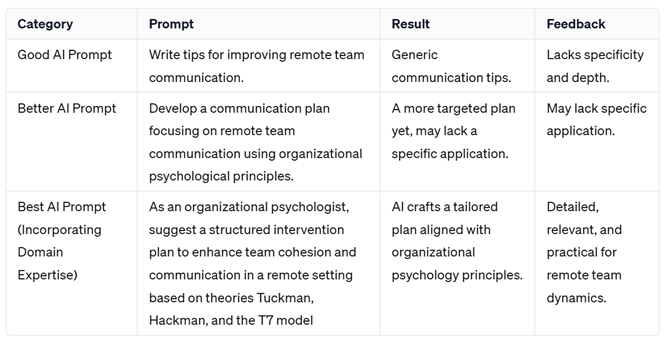McKinsey's research estimates that Generative AI could add a staggering $2.6 trillion to $4.4 trillion annually to the global economy, comparable to, or even exceeding, the GDP of major economies like the United Kingdom. In the swiftly evolving world of technology, integrating artificial intelligence (AI) like Chat GPT and Microsoft Copilot into our everyday work is an innovation and a revolution. Here are a few tips on how to do so effectively.

Learnings from Microsoft Copilot
The introduction of Microsoft Copilot just eight months ago has marked a significant transformation in the workplace. As a tool and catalyst, Copilot is redefining 'smart' work by enhancing productivity and creativity, leading us to question if generative AI can truly revolutionize work methods. Research recently published by Microsoft found that 77% of early users found Copilot indispensable.

The Quantifiable Transformation
Statistics from early adopters of Copilot demonstrate its impact:
70% report increased productivity.
68% see improvements in work quality.
64% spend less time on emails.
85% achieve better first drafts quicker.
Tasks like writing, summarizing, and searching are completed 29% faster.
Catching up on missed meetings is now 4x quicker.
These figures underscore a shift in technology utilization, moving beyond efficiency to enhance organizational capabilities.
Elevating Organizations: The Collective Leap Forward

Copilot goes beyond individual productivity enhancements, uplifting entire organizations by setting new performance baselines and equipping employees with improved writing and data analysis skills. This evolution amplifies human expertise, transforming good work into exceptional outcomes.
The journey with Copilot is clarifying AI's role in business. Its impacts include salespeople saving 90 minutes per week and a 44% increase in accuracy among security analysts. Copilot has evolved from a mere tool to a collaborative partner, reshaping roles and revolutionizing industries.
Microsoft said Copilot underscores that AI's power lies in its capabilities and how it's integrated into our workflows. This involves building a daily habit of interaction, applying human judgment alongside AI efficiency, and thinking strategically. The new frontier of work balances AI's computational power with human intelligence.
Based on these findings and my own experience, here are three concepts essential to understanding and utilizing generative AI capabilities:
The shift from deterministic to probabilistic computing
A new approach to informational retrieval from keywords to contextual prompt writing
Mastering the art of AI delegation
Understanding the Shift from Deterministic to Probabilistic Computing

The insights shared by Jared Spataro at the 2023 Charter Workplace Summit have been pivotal in understanding the AI revolution's trajectory. One of the most profound changes he highlighted is the transition from deterministic to statistical computing. This evolution in computing paradigms marks a significant shift in how we perceive and interact with technology, particularly in AI.
Understanding the Paradigm Shift from Deterministic to Probabilistic Computing
In deterministic computing models, the process is linear and akin to a mathematical equation. Inputs precisely lead to specific operations, resulting in a predictable and consistent output. This model has been the backbone of traditional computing systems for decades. An example of deterministic computing is a simple calculator program, where entering a specific arithmetic operation (like 2+2) always yields the same result (4). The reliability and certainty of outcomes in such models have been fundamental in various applications, from basic arithmetic to complex engineering simulations.
Probabilistic Computing: Embracing Uncertainty with AI
Contrastingly, generative AI, exemplified by tools like Microsoft Copilot, operates on probabilistic or statistical computing principles. This paradigm shift moves away from the absolute certainty of deterministic models to a realm where outputs are based on probabilities and predictions. Rather than a single, predictable outcome, AI provides a range of possible answers, each associated with a certain likelihood. This approach utilizes machine learning algorithms and extensive datasets to recognize patterns, learn from them, and make educated predictions or guesses.
This shift signifies a transition toward more adaptable and flexible computing solutions. Unlike the rigid, rule-based approach of deterministic models, statistical computing thrives in environments filled with uncertainty and variability. It offers solutions not confined to binary outcomes but represent a spectrum of probabilities. This flexibility is advantageous in complex, real-world scenarios with multiple variables and outcomes, and a single 'correct' answer is often elusive.
The Value of Probabilistic Computing
The probabilistic nature of statistical computing opens new avenues for problem-solving, particularly in scenarios where complexity and ambiguity prevail. It allows for a more nuanced understanding and management of real-world challenges, where absolutes are rare, and the best answers are often found in various possibilities.
Statistical computing excels in fields such as predictive analytics, where it can analyze vast amounts of data to forecast trends, behaviors, and outcomes. This predictive capability is invaluable in areas like marketing, finance, and healthcare, enabling more informed, strategic decision-making based on anticipated future patterns and trends.
Human Beware: There are Consequences to this Revolutionary Shift

The shift from deterministic to probabilistic computing brings significant consequences that require a recalibration of our expectations and approaches when interacting with AI. As we move into an era dominated by statistical computing, how we interpret and rely on technology undergoes a fundamental change. Unlike deterministic models that deliver precise and predictable outputs, AI systems based on probabilistic principles can sometimes present what is known as 'hallucinations' or generate information that, while statistically plausible, may not be factually correct or contextually appropriate.
This phenomenon of AI 'hallucinating' represents one of the critical challenges in the new computing landscape. Users must be acutely aware of this aspect to avoid being misled by AI-generated content. It necessitates a shift from a mindset of unwavering trust in computational outputs to one of critical evaluation and skepticism. It is crucial to understand that AI, despite its advanced capabilities, can still produce errors or misleading information. This understanding helps users maintain a balanced perspective, appreciating AI's immense potential while being alert to its limitations.
Humans must adopt a more active role in the AI interaction process to navigate this new terrain effectively. This involves feeding information to AI systems and critically evaluating their outputs, asking probing questions, and providing continuous feedback to refine the AI's learning and response accuracy. Humans must partner with AI, combining their contextual knowledge and judgment with AI's computational power to achieve the most accurate and useful results. By acknowledging and adapting to the probabilistic nature of AI, we can better harness its capabilities while mitigating the risks associated with its limitations.

The transition from deterministic to statistical computing represents a fundamental shift in the AI revolution, indicating a future where adaptability, flexibility, and predictive capabilities become central to our interaction with technology. This new computing era requires a deep understanding of these new principles and an openness to the evolving nature of problem-solving and decision-making in the digital age.
Embracing this shift also means adjusting our expectations. In a statistical computing world, outputs are not always about being right or wrong but about being probable or less probable. This requires a mindset change in how we interpret and utilize computing outputs. The probabilistic nature of its outputs means they must be interpreted, contextualized, and sometimes questioned. This is where human judgment and expertise play a critical role, ensuring that the technology is harnessed effectively and ethically.
A New Approach to Information Retrieval from Keywords to Context Prompts

The development of advanced AI models marks a significant transition in how we retrieve information. We are moving from the traditional keyword-based search methods to a more sophisticated approach involving context-rich prompt writing. This evolution demands a deeper, more nuanced interaction with technology, fundamentally changing our relationship with information retrieval tools.
Beyond Keywords: Embracing Context and Detail

Traditional search engines operate primarily on keyword inputs and return millions of search results. While effective for broad searches, this method often leads to sifting through numerous results to find the relevant information. It also requires the user to click, read, and summarize the information.
Example: To Team Effectiveness Theories and Models.
Results: 20 models are presented at the top of the screen, followed by an endless search results display.

Advanced AI models like ChatGPT require more than just keywords; they thrive on context and detail. By providing comprehensive background information, specific queries, and clear intentions, users can guide the AI to generate more precise and relevant responses.
This method transforms information retrieval from a mere query-response model to a conversational interaction. Users engage in a dialogue with AI, providing context, receiving responses, and refining their queries based on the information received.
Example: Play the role of an organizational psychologist and expert in team dynamics. summarize the top team effectiveness theories or models in the field.
Results: A concise list of six Team Effectiveness theories and models with a brief description of each. I could then ask Chat GPT to expand one or more of these models.
Traditional Search vs. AI Prompt in Technical Query:

Search: "Python error list index out of range"
Result: Returns general programming forums and documentation about the error.
ChatGPT Prompt: "I'm working on a Python project using lists, and I encountered an 'IndexError: list index out of range.' Here's my code snippet [...]. Can you help me identify why this error occurs and suggest a fix?"
Result: ChatGPT analyzes the provided code, identifies the issue causing the error, and offers a direct solution or code modification.
These examples demonstrate how the shift to context-rich prompt writing with AI like ChatGPT results in more efficient, relevant, and tailored information retrieval, transforming how we access and interact with information in the digital age.
Mastering the Art of AI Delegation

Another counter-intuitive finding shared by Spataro is how older knowledge workers had an easier time adopting Copilot than their younger counterparts. Given the Millennial and Gen Z generations are digital natives, this was a surprising finding. On further investigation, Spataro and his team found that the delegation's skill set was vital in effectively using Copilot and other generative AI tools.
In the rapidly evolving digital technology landscape, effectively delegating tasks to AI is advantageous and essential. AI operates uniquely on data, patterns, and probabilities, necessitating a strategic approach from human collaborators. This strategic interaction requires clarity and specificity in communication and an understanding of AI’s capabilities and limitations, coupled with an adaptive approach as AI technology continues to evolve. The integration of domain expertise is key to mastering delegation in the age of AI, which acts as a guiding compass in enhancing the interaction's effectiveness.
Essential Delegation Skills in the Age of AI
Precise and Detailed Task Specification: Clearly define tasks with explicit instructions, incorporating your field of expertise to provide a comprehensive framework. This involves outlining the scope, objectives, specific requirements, or constraints, ensuring the AI operates within a context it understands.
Iterative Communication and Feedback: Engage in a two-way process with AI, refining prompts based on the responses received. This ongoing dialogue, informed by your domain knowledge, ensures the AI's output aligns more closely with your expectations and professional needs.
Balanced Oversight and Autonomy: Allow AI a degree of autonomy but maintain crucial oversight to ensure accuracy and relevance. This balance is enriched by your domain expertise, enabling you to guide AI effectively and intervene when necessary.
Domain Expertise: domain expertise is critical in effectively delegating tasks to AI, ensuring the technology is aligned with your professional objectives. It enables you to catch errs and redirect AI toward a more accurate approach.
Applying these essential delegation skills transforms AI from a mere tool into a valuable asset, aiding in navigating complex professional challenges and unlocking AI's full potential.
Illustrating Delegation Skills with Good, Better, and Best AI Prompts
Try the following task using the prompts from the table below to see how Chat GPT's response get more informative and specific.
Task: Create a strategy for enhancing team cohesion in a remote work environment.

These examples demonstrate how integrating domain expertise into your prompts and iterative refinement significantly enhances AI's ability to produce relevant, high-quality outputs. By mastering these delegation skills and integrating your specialized knowledge, you can transform AI from a general tool into a specialized assistant that complements your professional skills and knowledge.
A Call for Collective Wisdom
We invite you to share your AI experiences and insights. Your journey, challenges, and strategies could be invaluable to those starting their AI journey. This is about adopting new technology and reshaping our interaction, delegation, and problem-solving approaches.
As AI evolves, so will our methods of interacting with it. Sharing our experiences and learning from each other will help us navigate the complexities of this exciting technology. Your contributions shape the future of how we work and collaborate with AI. Let us know your experience and insights in the comments.
*The illustrations included in this blog were created by ChatGPT using DALL-E 4 AI technology using the excerpts from the blog post.
टिप्पणियां